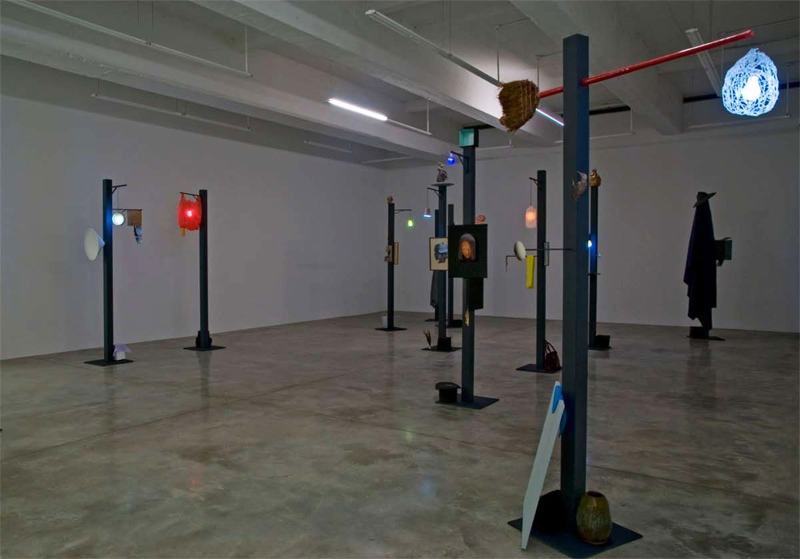
© » KADIST
Carter Mull
Mull’s Worker’s Clock collage works bring together images from the artist’s studio photography practice, found photographs, and pages from a phone book, laying them over a psychedelic warp of color in the background. One of the images is borrowed from a billboard, Double Block (for Alanna Pearl, Nik Nova and R. Mutt) (2013) that Mull created to hang above some storefronts in downtown Los Angeles. The pair of photographs features a woman posed in the center for rings of numbers, her body and shadow taking the place of the mechanical hands.
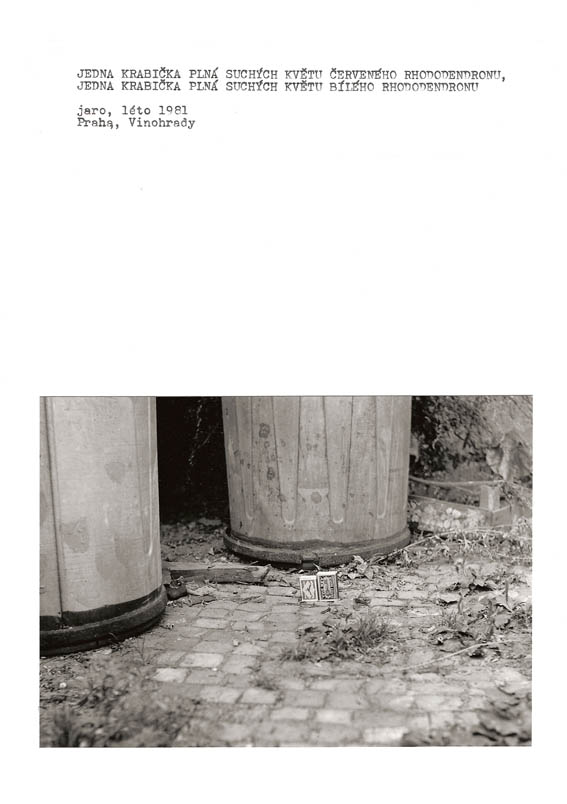
© » KADIST
Jiri Kovanda
Kovanda’s street interventions are always documented according to the same format as the actions: a piece of A4 paper, a typewritten text giving a precise location and date, and a photograph. Contrarily to the actions, he took the photographs himself. One of the rules he stuck to in his artistic practice was to always use material at his disposal, a real economy of means.

© » KADIST
Yuji Agematsu
Each day, Yuji Agematsu smokes a pack of cigarettes and wanders the streets of New York City looking for trash. Needless to say, he finds it everywhere: bottle caps, gummed hair, translucent miscellany, sick feathers, hot pink plastics, unknown, and more. The varied bits are then constellated by the artist in cellophane cigarette wrappers—modest vitrines for his steady collecting habit.
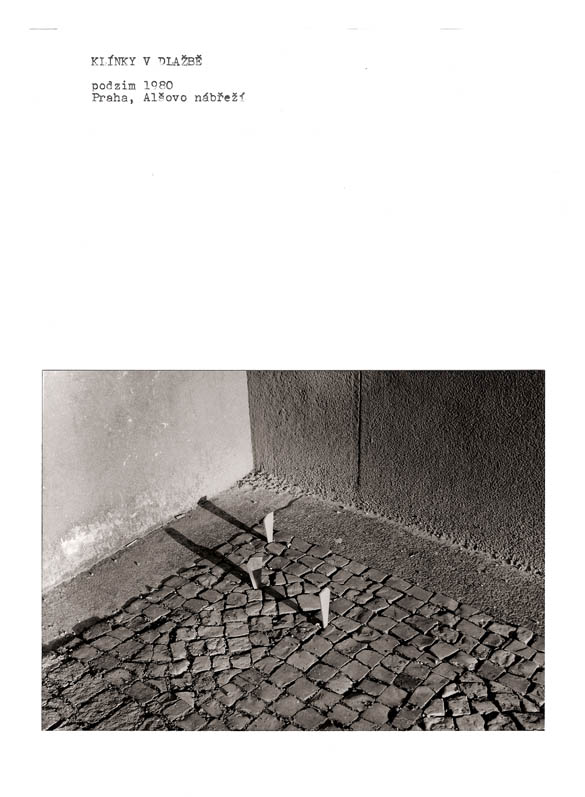
© » KADIST
Jiri Kovanda
Kovanda’s street interventions are always documented according to the same format as the actions: a piece of A4 paper, a typewritten text giving a precise location and date, and a photograph. Contrarily to the actions, he took the photographs himself. One of the rules he stuck to in his artistic practice was to always use material at his disposal, a real economy of means.

© » KADIST
Nora Schultz
Halfway between a painting and an installation City Sound of Rug gathers found images, synthetic foam, painted metal plates, and prints placed on the floor. Rugs are elements representative of commerce and related to the idea of territory, handicraft and community. In City Sound of Rug, the rugs are used as surfaces upon which prints are manually made.

© » KADIST
Adriano Costa
Westminster Agua Viva is made from Westminster City Council(‘s) recycling bin bags, glued together, that the artist has painted and cut or cut and painted. Although, they hang on the wall they possess a strong sculptural quality as the fringes float away from the wall. This is part of a series of works that refer to Brazilian concrete and neo-concrete art as well as Arte Povera in a playful manner while demonstrating a strong identity of its own.

© » KADIST
Colter Jacobsen
Victory at Sea is a simple mechanism made from cardboard and found materials that mimics the Phenakistoscope, an early cinematic apparatus. The piece requires the viewer to turn a wheel and look through a small hole in order to see a briefly animated succession of small drawings of sailors.
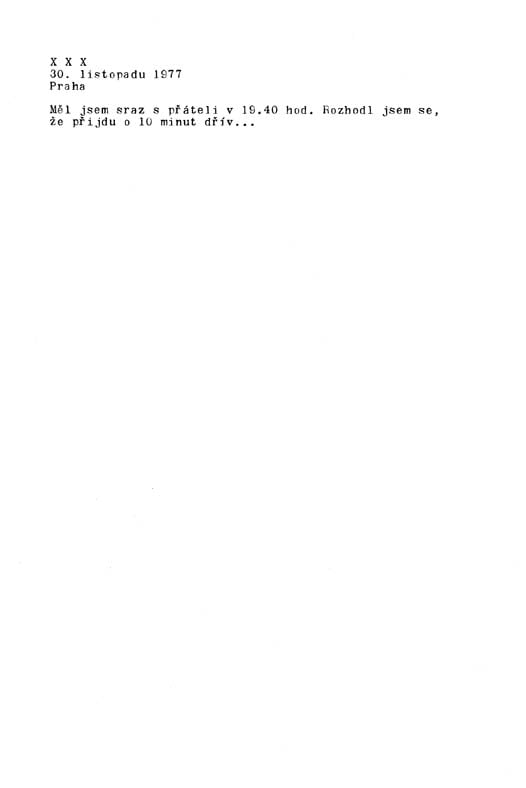
© » KADIST
Jiri Kovanda
Drawing & Print (Drawing & Print)
All Kovanda’s artistic practice poses the question of visibility. Having worked on actions and performance, the artist decided to ‘disappear’ from his artworks during twenty years; in 2007, his performance Kissing through glass in the institutional setting of Tate Modern was acclaimed by critics. Some works are only visible thirty years later via traces and archives; the artist’s rehabilitation by institutions and galleries offers a new critical reading of his practice which had until then remained rather confidential.

© » KADIST
Colter Jacobsen
Drawing & Print (Drawing & Print)
The title Untitled Passport II was first used by Felix Gonzalez-Torres in an unlimited edition of small booklets, each containing sequenced photographs of a soaring bird against an open sky. Stacked in the shape of a cube and available for visitors to take away, the passports did not offer citizenship, but rather invited participation in a sense of borderless “being.” Colter Jacobsen’s Untitled (Untitled Passport II) is a diptych showing two-page spreads from Gonzalez-Torres’s booklet. The perfect graphite renderings freeze the book with its pages splayed, wings perpetually open.

© » KADIST
Barbara Bloom
In the 1980’s, while browsing Parisian fleamarkets, Barbara Bloom stumbled into an anonymous watercolor (dating to around 1960) in one of Paris’ fleamarkets, probably a study made by an interior designer for a bedroom. The artist found the image to be typically Parisian. The watercolor, framed under a mat made of cardboard, had color tests on its margin, elements that Bloom discovered when she raised it.
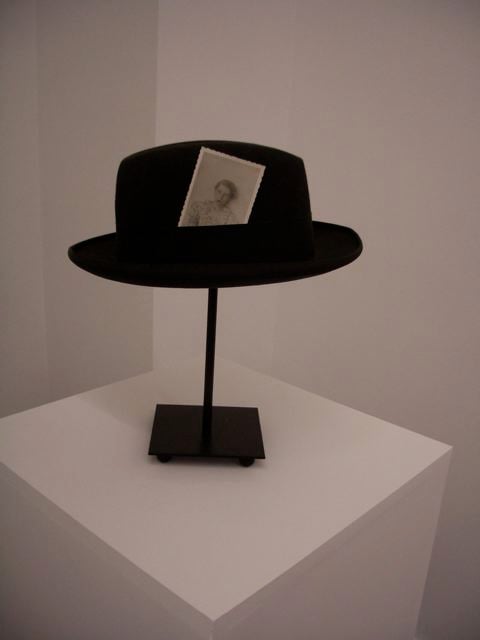
© » KADIST
Hans-Peter Feldmann
The types of objects Feldmann is interested in collecting into serial photographic grids or artist’s books are often also found in three dimensional installations. Hats and photographs are regularly part of his appropriations and arrangements. He famously made numerous trips to England in search of old photographs when he was an antique dealer, and then worked in a gift store with his wife when he left the art world in the 1980s.
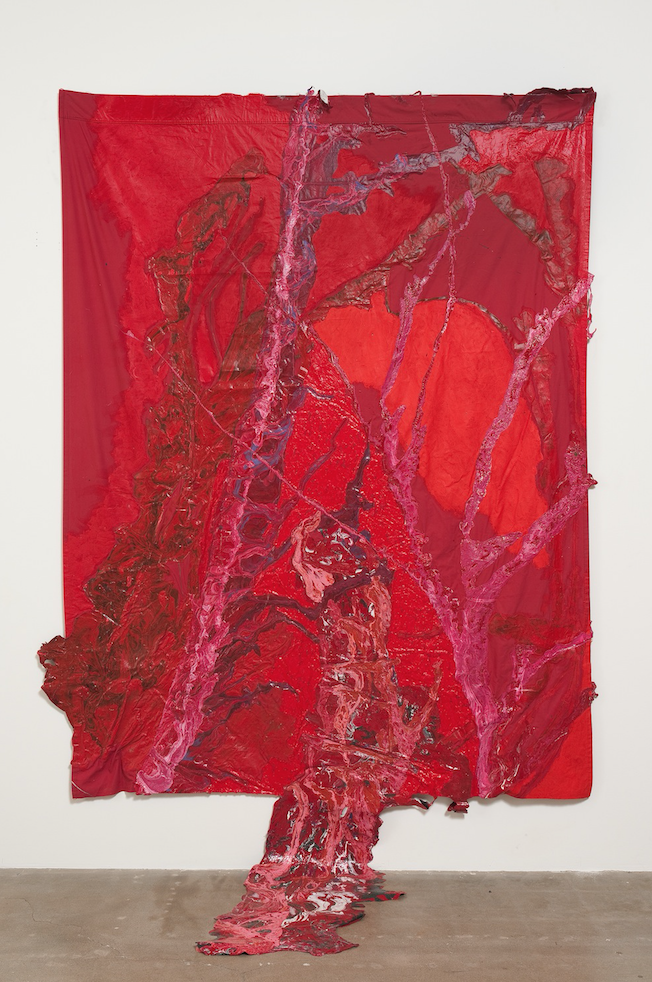
© » KADIST
Rodney McMillian
In his evocative Landscape Paintings, McMillian uses second-hand bedsheets, sourced from thrift shops, as his starting point. Calling up the unknown intimacies of these objects, McMillian upends their usual orientation, placing them directly on the wall to serve as paintings, rather than covers. Layering over the repurposed textiles with hardware store paint, McMillian transforms the sheets into canvases, creating abstract landscapes on top of the traces of human bodies intact in the fabric.

© » KADIST
Mark Bradford
Drawing & Print (Drawing & Print)
This untitled work from 2012 is a print originally made as part of the Wattis Institute for Contemporary Art’s artist limited edition series. It’s contrasting dark and vibrant tones presage his later series of works, exhibited at L. A.’s Hammer Museum as Scorched Earth. These larger works share a map-like quality, looking like aerial views of some scarred urban landscape.
Jiri Kovanda
- location: Praha, Ceská Republika
- year born: 1953
- gender: male
- nationality: Czech
Colter Jacobsen
Since 2003, Colter Jacobsen has gained in visibility and importance in the Bay Area art scene...
Adriano Costa
Adriano Costa is a Brazilian artist (born in1975) living in Sao Paolo....
Nora Schultz
Born 1975, Frankfurt / Main, Germany Lives and works in Berlin Nora Schulz explores the relations between painting, sculpture, performance, and language...
Barbara Bloom
Collector Barbara Bloom mixes autobiographical details, fictional narratives, and literary quotes...
Abraham Cruzvillegas
- location: Mexico
- year born: 1968
- gender: male
- nationality: Mexican
- home town: Mexico City, Mexico
Mark Bradford
- location: Los Angeles, California
- year born: 1961
- gender: male
- nationality: American
- home town: Los Angeles, California
Jason Fulford
Photography and book publishing are inextricable in the work of Jason Fulford...
Yuji Agematsu
Yuji Agematsu is an artist who works across various media, including sound, photography, and the arrangements of objects—not exactly sculpture...
Carter Mull
Los Angeles-based artist Carter Mull is an obsessive sort, and his fascinations show through in his multimedia photographic and installation-based works...
Rodney McMillian
- location: Los Angeles, California
- year born: 1969
- gender: male
- nationality: American
- home town: Columbia, South Carolina
Hans-Peter Feldmann
- location: Düsseldorf, Germany
- year born: 1941
- gender: male
- nationality: German
- home town: Dusseldorf, Germany
-
1970-1979
Jiri Kovanda
Drawing & Print
1977(Drawing & Print) All Kovanda’s artistic practice poses the question of visibility...
-
1980-1989
Jiri Kovanda
1980Kovanda’s street interventions are always documented according to the same format as the actions: a piece of A4 paper, a typewritten text giving a precise location and date, and a photograph...
Jiri Kovanda
1980Kovanda’s street interventions are always documented according to the same format as the actions: a piece of A4 paper, a typewritten text giving a precise location and date, and a photograph...
-
1990-1999
Barbara Bloom
1997In the 1980’s, while browsing Parisian fleamarkets, Barbara Bloom stumbled into an anonymous watercolor (dating to around 1960) in one of Paris’ fleamarkets, probably a study made by an interior designer for a bedroom...
-
2000-2009
Colter Jacobsen
2007Victory at Sea is a simple mechanism made from cardboard and found materials that mimics the Phenakistoscope, an early cinematic apparatus...
-
2010-2019
Colter Jacobsen
Drawing & Print
2010(Drawing & Print) The title Untitled Passport II was first used by Felix Gonzalez-Torres in an unlimited edition of small booklets, each containing sequenced photographs of a soaring bird against an open sky...
Mark Bradford
Drawing & Print
2012(Drawing & Print) This untitled work from 2012 is a print originally made as part of the Wattis Institute for Contemporary Art’s artist limited edition series...
Carter Mull
2013Mull’s Worker’s Clock collage works bring together images from the artist’s studio photography practice, found photographs, and pages from a phone book, laying them over a psychedelic warp of color in the background...
Nora Schultz
2013Halfway between a painting and an installation City Sound of Rug gathers found images, synthetic foam, painted metal plates, and prints placed on the floor...
Rodney McMillian
2013In his evocative Landscape Paintings, McMillian uses second-hand bedsheets, sourced from thrift shops, as his starting point...
Adriano Costa
2014Westminster Agua Viva is made from Westminster City Council(‘s) recycling bin bags, glued together, that the artist has painted and cut or cut and painted...
Yuji Agematsu
2015Each day, Yuji Agematsu smokes a pack of cigarettes and wanders the streets of New York City looking for trash...




